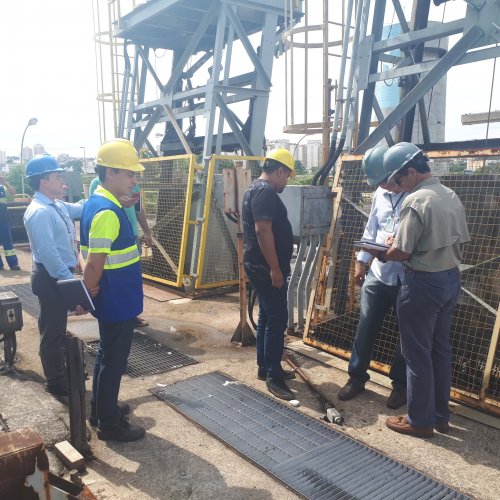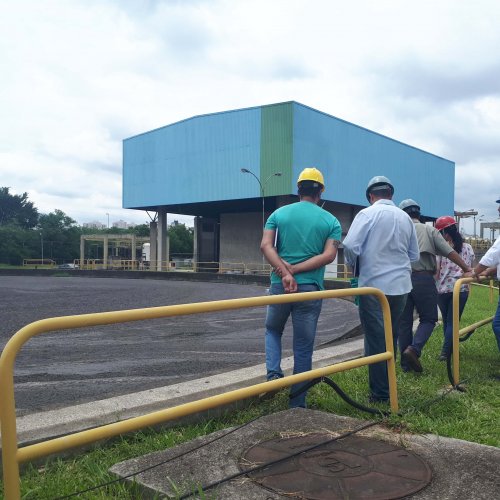2030 WRG and SABESP team up to tackle wastewater treatment in São Paulo Metropolitan region
Versão em português abaixo
By Stela Goldenstein, 2030 WRG Brazil Country Coordinator
The São Paulo Metropolitan Region, with 39 municipalities and more than 21 million inhabitants, has a complex sewage collection, removal, and treatment system. Currently, 87% of the volume of sewage generated in the region is collected. According to the government’s targets, by 2025, the collection should cover 92% of the generated sewage, and 85% of it should be sent for treatment.

Although these are very significant indicators of sanitation as compared to most large Brazilian cities, the volume of water that the rivers of the São Paulo Basin (Alto Tietê Basin) provide is still insufficient to dilute all the sewage load in natura that these rivers receive, making them extremely polluted.
Most of the collected sewage in the region is sent to five large wastewater treatment plants (WWTPs), which were designed according to international manuals and standards of sanitary engineering from developed countries. However, due to the specific characteristics of the sewage in a large Brazilian city like São Paulo and to other technical factors, these facilities have operational problems that reduce their pollution removal efficiency. Considering that the expansion of the collection networks in urban areas is underway, and that there will be an increase in the sewage flows to be sent to these same facilities, it is crucial to prioritize strategic investments in maximizing the performance of the existing WWTPs instead of duplicating or building new infrastructure (as is traditionally thought), which is far more costly and time-consuming.
At the beginning of 2019, the 2030 WRG and SABESP, the public sanitation company of the State of São Paulo, joined efforts to develop and implement a performance optimization program in the five largest treatment plants operating in the São Paulo metropolitan area, starting with the Barueri and the Parque Novo Mundo WWTPs. The program aims to improve the quality of final effluents discharged back to the environment and prepare these facilities to properly receive increased sewage loads and also incorporate circular economy processes.

The adopted methodology for the next steps, developed with technical support from international expert Daniel Nolasco, involves the evaluation of historical data of operations, the introduction of measuring and monitoring equipment, and the auditing and performance analysis of each step of the sewage treatment process at every WWTP, including monitored tests. These steps will allow for the checking of the current efficiency of each process or phase, the detection of operational bottlenecks, and the identification of corrective measures for maximizing performance at a reasonable cost, without the need for new infrastructure.
Very positive results of this program have already been obtained at the Barueri WWTP (ETE Barueri), such as the expansion of the plant’s capacity to remove grit and sand materials (pre-treatment) and the reduction of BOD concentration in the final effluent discharged into the Tietê River. Other positive outcomes include the consolidation of a performance-based contracting strategy for the purchase of equipment, and a greater integration of the different boards of SABESP around common goals.
With the continuity of the program, this set of WWTPs will have a significant increase in operational performance. The five facilities will be able to guarantee compliance with the project standards on pollution removal and even exceed them, which will significantly contribute to the improvement of water quality in the region. By 2022, the program’s goal is to achieve a 90 to 95% pollution load removal capacity in the 5 regional WWTPs, which should receive a total volume of about 21 m3/sec.
Versão em português:
A Região Metropolitana de São Paulo, com 39 municípios e mais de 21 milhões de habitantes, conta com um complexo sistema de coleta e tratamento de esgoto. Atualmente, 87% do volume de esgoto gerado na região é coletado, e 78% é enviado para tratamento. De acordo com as metas governamentais, até 2025, a coleta deverá abranger 92% do esgoto gerado, e 85% do esgoto coletado deverá ser enviado para tratamento.
Embora sejam indicadores de saneamento muito expressivos em comparação à maioria das grandes cidades brasileiras, os rios da bacia paulistana (Bacia do Alto Tietê) têm volume reduzido de água, insuficiente para diluir a carga de esgoto in natura que ainda recebem, gerado pela significativa concentração de população, o que os torna extremamente poluídos.
O esgoto coletado é enviado para 5 grandes estações de tratamento (ETEs). Com a ampliação da rede de coleta nas áreas urbanas, em andamento, e o aumento das vazões de esgoto a serem enviadas para estas mesmas ETEs, torna-se dramaticamente importante investir para melhorar a eficácia dos processos de tratamento. No início de 2019, em um trabalho conjunto, o 2030 WRG e a SABESP deram início a um programa de otimização do desempenho das ETEs da Região Metropolitana de São Paulo, visando a melhorar a qualidade dos seus efluentes finais, a receber os novos volumes de esgotos e a prepará-las para incorporar processos de economia circular.
O desafio foi aceito, o projeto está em andamento e o 2030 WRG apoia ativamente a SABESP na implementação do programa. A metodologia adotada, desenvolvida em conjunto com a equipe da SABESP e o especialista internacional Daniel Nolasco, envolve vários procedimentos, como: a avaliação de dados históricos; a introdução de equipamentos para medição e monitoramento; a auditoria e a análise do desempenho de cada etapa do processo de tratamento de esgoto em cada ETE, etc. O objetivo é identificar as deficiências, os gargalos infraestruturais e operacionais, e as necessidades de investimento para a sua correção.
Concebido, facilitado e financiado pelo 2030 WRG e pela SABESP, o programa, em suas etapas iniciais, envolveu a realização de visitas de reconhecimento às ETEs, a discussão dos achados em workshops internos, e a definição conjunta das etapas, procedimentos e metas do programa. Resultados muito positivos já foram obtidos na ETE Barueri, como a ampliação da capacidade de remoção de sólidos grosseiros e areia (pré-tratamento) e a redução da concentração de DBO no efluente lançado no Rio Tietê. Outros resultados já alcançados pelo programa são a consolidação de uma estratégia de contratação por performance para a compra de equipamentos e uma maior integração das diferentes diretorias da SABESP em torno de metas comuns.
Com a continuidade do programa, o conjunto das ETEs da RMSP terá expressivo incremento em sua eficácia operacional, atingindo e superando as metas de projeto quanto à remoção das cargas de poluição, o que contribuirá significativamente a melhoria da qualidade das águas na região.
Para 2022, o programa estabelece como meta alcançar uma capacidade de remoção de carga de poluição entre 90 a 95% nas 5 ETEs em operação na região, as quais receberão uma vazão total de esgoto de cerca de 21 m3/s.
